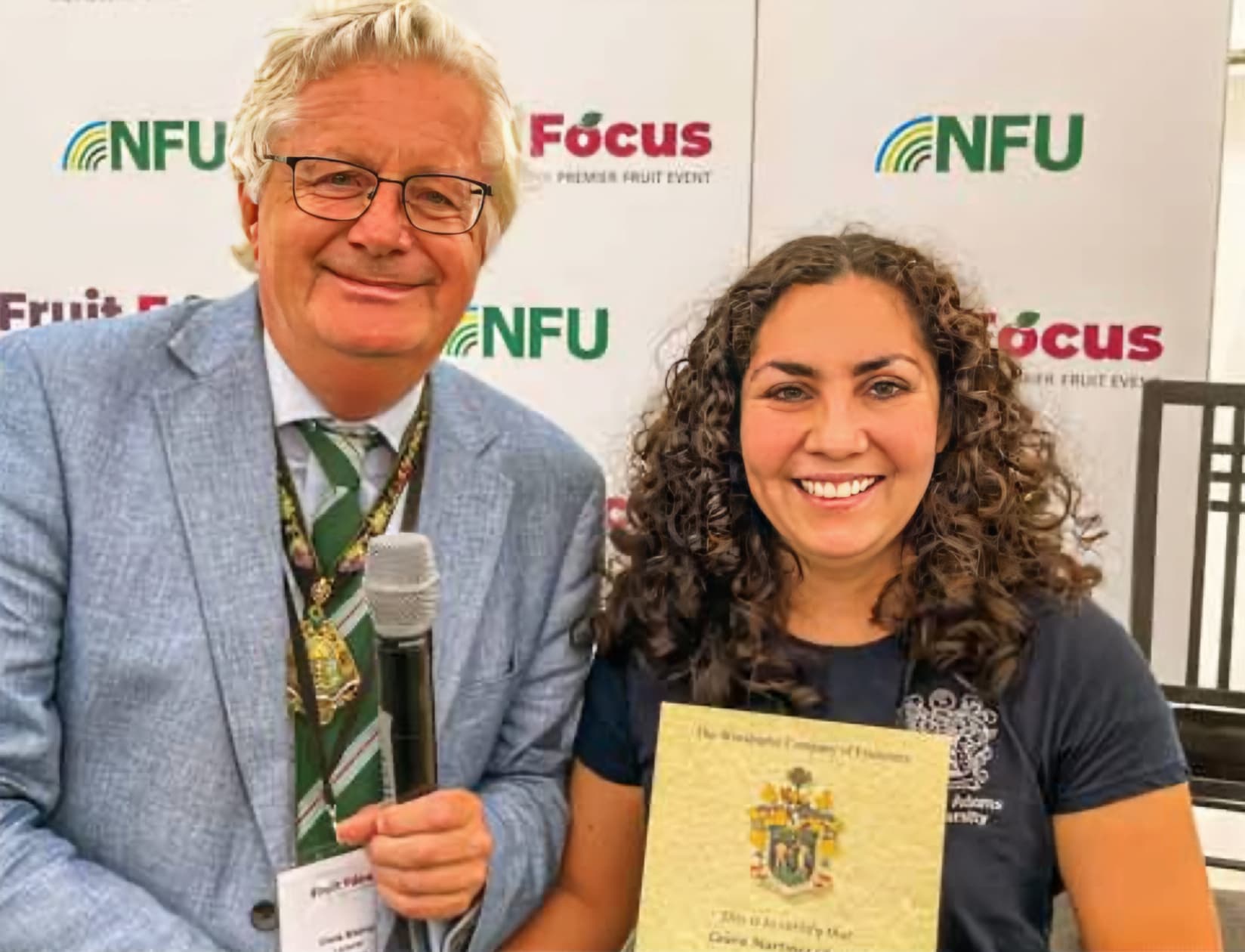Laura Martinez Chavez was the recipient of this year’s Student Essay Prize at Fruit Focus in early July. Here, she explains the aims and objectives that are driving her research, which is benefiting from funds raised by Fruiterers.
Could you explain your research project and what its specific aims are?
My research project aims to understand the diversity of potato aphid populations (in terms of their genetics and endosymbiotic bacterial infections) attacking strawberry crops in the UK and how that diversity can influence the interactions of those populations with the parasitoid species used in biological control programmes on those crops.
How long has the project been running and what have you discovered so far?
The project has been running for almost three years now. We have found a greater diversity of genotypes and bacterial endosymbiont infections in potato aphid populations than we expected. At the moment, we have collected 15 completely different populations, all attacking strawberry crops around the country.
By doing parasitism experiments in the laboratory, we have understood that those populations are all differentially susceptible to one of the most common parasitoid species used for potato aphid control (Aphidius ervi). That has raised multiple questions: what is driving that difference? Is this laboratory observation also happening in the field?
• Up to date we are continuing to establish the role of the aphid genetics and endosymbiotic bacteria in generating those different parasitism levels under control conditions. It seems that aphid intrinsic genetics have a limited effect, although the results on endosymbiotic bacteria are still pending.
• From two years of field assessments on a strawberry farm, we have collected data on parasitism pressures, aphid abundance and distribution in polytunnels, aphid genotypes, and aphid endosymbiotic bacterial infections. Preliminary results have shown that:
1. Potato aphids’ abundance is peaking at the end of the growing season.
2. Parasitism pressures are at the lower end for potato aphids all year (with an average of 7.5%) but peak with greater aphid abundance.
3. There is a difference in potato aphid pressures depending on the size of the polytunnel, with smaller polytunnels having greater pressures.
Other questions about the parasitoids themselves and their potential to adapt to these variabilities in the susceptibility of their host population are also being addressed.
Why is the research important to fruit growers and the wider industry – what are the potential implications of your findings on strawberry production in the UK and beyond?
I think that trying to understand what is causing the problems that the industry has raised when using biocontrol is key for biocontrol to be adopted and implemented in the wider industry. For example, in this case we worked on the fact that, for some farmers, potato aphid has been difficult to control in the last couple of years. These results are important for the fruit growers and wider industry as we are relying on biocontrol more and more but have limited understanding of how it works and what factors influence its efficiency.
The potential implications of the results of this study might be understanding that potato aphid populations (as with other aphid species) are not all equally susceptible to certain parasitoid species, and that different approaches for its control might be needed—such as using different species (mixes) and getting parasitoids with greater genetic diversity so that they can adapt to different levels of resistance on their hosts. Although this research has been done in the UK, aphids are a worldwide pest, and similar resistance to biocontrol has been found in other countries and crops, making it a worldwide problem. With this study we are not only aiming to reach the UK strawberry production industry but also other industries around the globe that might be facing similar challenges.
When do you think your work will be completed?
My research on this specific topic hopefully will be completed by the end of next year (2025). However, it is important to understand that the results probably will lead to other important research questions that should continue to be addressed.
How about you, Laura, can you tell us a bit about yourself?
I am from Colombia. I did my undergraduate studies in Entomology in my country and I have been working abroad since then. I did my Masters in Spain on genetics and cell biology, then decided that I wanted to apply what I learnt during my Masters course back into Entomology. I looked for a PhD opportunity that would allow me to do that and found at Harper Adams the opportunity not only to do that but to connect with an important industry like the soft-fruit industry.
What are your longer-term ambitions?
I am still undecided on what I will specifically do. But what I know is that I would like to continue to do meaningful contributions to the future of pest control by helping to translate data into decisions that enable growers to unlock pathways to rural sustainability. And that can be achieved either by working in the fruit industry itself or working in academia and collaborating closely with the fruit industry and the wider agriculture industry.
How did you become aware of the Student Essay Prize?
I am lucky enough to be part of the CTP Fruit Crop Research PhD programme run by NIAB – East Malling. They constantly share opportunities with us, and the Student Essay Prize has been one that I have been aware of since I started.
I am thankful not only for winning the award but also for my research to be recognised as useful for the soft crop industry. I think that is every researcher’s goal. I hope that with winning the prize more people in the industry will be aware of the research we are doing and the results so far. I think that the prize highlights the importance of the collaboration of scientific and academic researchers with industries in approaching different challenges.
Who else are you working with and how does Harper Adams support your work?
Although this is a PhD project, it would be impossible to do without collaboration with so many people. We have worked together with the James Hutton Institute. Also, different members of staff at Harper Adams, such as laboratory managers, have been essential for the development of the project. But especially the support of the strawberry industry and particularly farm managers who have sent samples, opened their fields for us to do field work, and discussed with us the importance of the project and its limitations.
Harper Adams as an institution has been key for this PhD project, not only because of its staff and infrastructure but because of its connections around the agriculture industry that have allowed us to approach the soft-fruit industry with more confidence.

